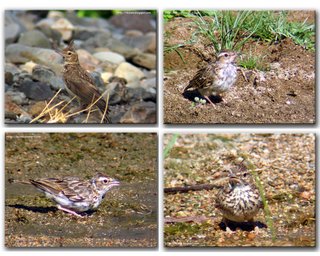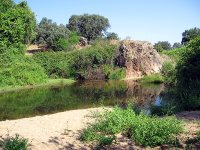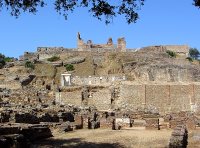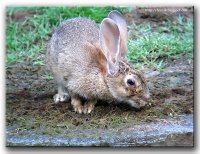ARENILLAS (VILLANUEVA DEL RIO-SEVILLA)

Crónica 09/07/2006
Hoy he ido acompañado de Diego a Arenillas en Villanueva del Río y Minas (Sevilla). Hace tiempo que quería ir a este sitio, porque había escuchado hablar bien de él. Salimos temprano de Sevilla, tomamos café en el camino y llegamos a Arenillas. Sabíamos que había una poza de agua cerca de las ruinas romanas de Mulva-Munigua y hacia allí nos dirigimos para ponernos la red de camuflaje y esperar en la poza.
Pudimos hacer algunas fotos y estudiar el terreno y los posaderos para una próxima visita con el hide. Reseñar la observación de Golondrina Daúrica (Hirundo daurica) en la poza. Más tarde nos dirigimos hacia las ruinas romanas e hicimos una corta visita, acompañado del guarda forestal "Quini" que nos estuvo explicando que el asentamiento romano data del siglo I y que aprovechaban unos yacimientos de hierro y cobre, también estuvimos charlando de pájaros con él y nos comentó que la poza de agua no se seca en todo el año, por lo que es un buen sitio para hacer fotos, aprovechando que los pájaros bajan a beber, pero quizás haya que esperar que se seque un poco más. Ya de vuelta a casa, paramos en el río Parroso y durante media hora estuvimos observando algunos pájaros. Pude ver las siguientes aves:
Today I have gone accompanied of Diego to Arenillas in Villanueva del Rio (Seville). Some time ago that wanted to go to this site, because had listened to speak well about it. We work out early of Seville, take coffee in the way and come to Arenillas. We knew that there was a water puddle near Mulva-Munigua's Roman ruins and towards there we go to put on the net of camouflage and to wait in the puddle. We could make some photos and study the area and the innkeepers for a close visit with the hide. To outline the observation of Red-rumped Swallow (Hirundo daurica) in the puddle. Later we go towards the Roman ruins and we did a short visit, accompanied of the ranger "Quini" who was making clear to us that the Roman accession dates back of the century I and that they were taking advantage of a few deposits of iron and copper, also we were chatting about birds with him and he commented to us that the water puddle does not dry off in the whole year, for what it is a good site to do photos, taking advantage that the birds lower to drinking, but probably be necessary to hope that it dries off a bit more. Already from return to house, we stop in the river Parroso and during half an hour we were observing some birds. I could see the following birds:
Garceta Común (Egretta garzetta), Garza Imperial (Ardea purpurea), Cernícalo Vulgar (Falco tinnunculus), Perdiz Roja (Alectoris rufa), Tórtola Común (Streptopelia turtur), Paloma Torcaz (Columba palumbus), Mochuelo Común (Athene noctua), Vencejo Común (Apus apus), Martín Pescador (Alcedo tais), Abejaruco Común (Merops apiaster), Abubilla (Upupa epops), Cogujada Común (Galerida cristata), Terrera común (Calandrella brachydactyla), Golondrina Común (Hirundo rustica), Golondrina Daúrica (Hirundo daurica), Avión Común (Delichon urbica), Mirlo Común (Turdus merula), Curruca Cabecinegra (Sylvia melanocephala), Herrerillo Común (Parus caeruleus), Carbonero Común (Parus major), Alcaudón Real (Lanius excubitor), Alcaudón Común (Lanius senador), Rabilargo (Cyanopica cyanus), Estornino Negro (Sturnus unicolor), Jilguero (Carduelis carduelis).
Poza de agua.

Ruinas de Mulva-Munigua

Conejo con mixomatosis que bajó a beber a la poza.

- Water puddle
- Mulva-Munigua's Ruins
- Rabbit with mixomatosis that went down to drinking to the puddle
Eso es todo.
Foto: Cogujada común (Galerida cristata)
Photo: Crested Lark (Galerida cristata)
Más fotos en: http://www.galeriade.com/fezave







0 Comments:
Publicar un comentario
<< Home